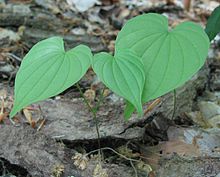Dioscorea villosa: Difference between revisions
No edit summary |
Incorrect bracket use |
||
| Line 18: | Line 18: | ||
Usually found wild in the eastern half of North America, it is a perennial plant that is a low creeper, and occupies average to poor soils and full sun. |
Usually found wild in the eastern half of North America, it is a perennial plant that is a low creeper, and occupies average to poor soils and full sun. |
||
It has been hypothesized |
It has been hypothesized 1 that wild yam ( Dioscorea villosa and other Dioscorea species) possesses dehydroepiandrosterone (DHEA)-like properties and acts as a precursor to human sex hormones such as estrogen and progesterone 2. Based on this proposed mechanism, extracts of the plant have been used to treat painful menstruation, hot flashes, and headaches associated with menopause {{Citation needed|date=October 2010}}. However, these uses are based on a misconception that wild yam contains hormones or hormonal precursors - largely due to the historical fact that progesterone, androgens, and cortisone were chemically manufactured from Mexican wild yam in the 1960s {{Citation needed|date=October 2010}}. It is unlikely that this chemical conversion to progesterone occurs in the human body {{Citation needed|date=October 2010}}. The hormonal activity of some topical wild yam preparations has been attributed to adulteration with synthetic progesterone by manufacturers, although there is limited evidence in this area {{Citation needed|date=October 2010}}. |
||
The effects of the wild yam saponin constituent "[[diosgenin]]" on lipid metabolism are well documented in animal models and are possibly due to impaired intestinal cholesterol absorption {{Citation needed|date=October 2010}}. However, its purported hypocholesterolemic effect in humans and the feasibility of long-term use warrant further investigation {{Citation needed|date=October 2010}}. |
The effects of the wild yam saponin constituent "[[diosgenin]]" on lipid metabolism are well documented in animal models and are possibly due to impaired intestinal cholesterol absorption {{Citation needed|date=October 2010}}. However, its purported hypocholesterolemic effect in humans and the feasibility of long-term use warrant further investigation {{Citation needed|date=October 2010}}. |
||
Revision as of 07:22, 20 May 2011
| Dioscorea villosa | |
|---|---|

| |
| Scientific classification | |
| Kingdom: | |
| (unranked): | |
| (unranked): | |
| Order: | |
| Family: | |
| Genus: | |
| Species: | D. villosa
|
| Binomial name | |
| Dioscorea villosa | |
Dioscorea villosa is a species of a twining tuberous vine that is native to and found growing wild in North America. Its fame is based on its steroid-like saponins which can be chemically converted to progesterone contraceptives; and cortisone.
Wild Yam is believed to be helpful to the liver and endocrine system. It regulates the female system, particularly during menstrual distress and menopause,as well as used in treating infertility. Used with chasteberry and dandelion it is an effective treatment for morning sickness [citation needed].
Usually found wild in the eastern half of North America, it is a perennial plant that is a low creeper, and occupies average to poor soils and full sun.
It has been hypothesized 1 that wild yam ( Dioscorea villosa and other Dioscorea species) possesses dehydroepiandrosterone (DHEA)-like properties and acts as a precursor to human sex hormones such as estrogen and progesterone 2. Based on this proposed mechanism, extracts of the plant have been used to treat painful menstruation, hot flashes, and headaches associated with menopause [citation needed]. However, these uses are based on a misconception that wild yam contains hormones or hormonal precursors - largely due to the historical fact that progesterone, androgens, and cortisone were chemically manufactured from Mexican wild yam in the 1960s [citation needed]. It is unlikely that this chemical conversion to progesterone occurs in the human body [citation needed]. The hormonal activity of some topical wild yam preparations has been attributed to adulteration with synthetic progesterone by manufacturers, although there is limited evidence in this area [citation needed].
The effects of the wild yam saponin constituent "diosgenin" on lipid metabolism are well documented in animal models and are possibly due to impaired intestinal cholesterol absorption [citation needed]. However, its purported hypocholesterolemic effect in humans and the feasibility of long-term use warrant further investigation [citation needed].
There are few reported contraindications to the use of wild yam in adults [citation needed]. However, there are no reliable safety or toxicity studies during pregnancy, lactation, or childhood [citation needed].
Some herbalists recommend Wild Yam as a natural contraceptive or birth control measure.
References
- 1. http://www.nlm.nih.gov/medlineplus/druginfo/natural/970.html
- 2. Eagon PK, Elm MS, Hunter DS, et al. Medicinal herbs: modulation of estrogen action. Era of Hope Mtg, Dept Defense; Breast Cancer Res Prog, Atlanta, GA 2000;Jun 8-11.
External links
- PLANTS profile
- Wild yam from University of Maryland Medical Center
- Wild Yam Cream article on Quackwatch
- An Herbal Contraceptive
